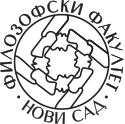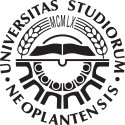15MD032 - Historical Syntax of the Serbian Language
| Course specification | ||||
|---|---|---|---|---|
| Course title | Historical Syntax of the Serbian Language | |||
| Acronym | 15MD032 | |||
| Study programme | Teaching Methodology | |||
| Module | ||||
| Type of study | third degree doctoral academic studies | |||
| Lecturer (for classes) | ||||
| Lecturer/Associate (for practice) | ||||
| Lecturer/Associate (for OTC) | ||||
| ESPB | 10.0 | Status | ||
| Condition | Oblik uslovljenosti | |||
| The goal | The objective of the course is to acquaint students with: (1) the principles and methodology of historical syntax, and (2) the causes and consequences of the syntactic changes in Serbian | |||
| The outcome | After the course the student is able to: (1) know what are the relevant research questions in historical syntax, (2) recognise and interpret the external and internal motivation of syntactic changes in Serbian from the Old Serbian period to the twentieth century, (3) explain the syntactic phenomena in Old Serbian texts, (4) diachronically explain the modern Serbian syntactic phenomena. | |||
| Contents | ||||
| Contents of lectures | 1. Key questions for historical syntax (Interpreting historical data; Spoken versus written texts; Determinants of syntactic changes: structural processes, typological factors, functional factors, pragmatic factors; Syntactic changes caused by language contact); 2. The syntax of simple sentences (The structure of the simple sentence in Late Proto‑Slavic; Changes in the sentence pattern; Clausal constituent: subject, object, predicate, agreement, negation; Word order: the order of subject and verb, the order of object and verb, the order of direct objects and indirect objects, the position of adverbs, consequences of word-order change; The noun phrase: the head of the noun phrase, determiners; The verb phrase: tense, aspect, topicalization, complementation); 3. Coordination (Syntactic, semantic, and pragmatic conditions of coordination; Juxtaposition; Between hypotaxis and parataxis; Markers of coordination; Coordination through connectors; Sources for connectors; Position of connectors; Coordination patterns); 4. Subordination (Subordination through subordinators; Sources for subordinators; Position of connectors subordinators; Complementation; Relativization; Adverbial subordination: purpose and result, conditionals and concessives, causals, temporals, comparatives). | |||
| Contents of exercises | Reading and syntactic analysis of Old Serbian texts | |||
| Literature | ||||
| ||||
| Number of hours per week during the semester/trimester/year | ||||
| Lectures | Exercises | OTC | Study and Research | Other classes |
| 5 | 2 | |||
| Methods of teaching | (1) Lecture, (2) class discussion, (3) presentation, (4) problem solving | |||
| Knowledge score (maximum points 100) | ||||
| Pre obligations | Points | Final exam | Points | |
| Activites during lectures | 50 | Test paper | 50 | |
| Practical lessons | Oral examination | |||
| Projects | ||||
| Colloquia | ||||
| Seminars | ||||

